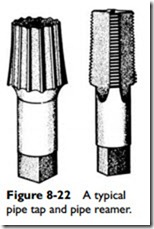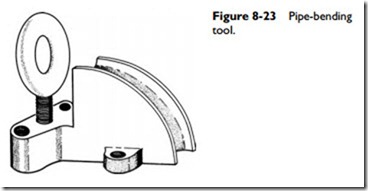Pipe Reaming
The burrs should be removed with a reamer to avoid future trouble with clogged pipes. This is a job that should be done thoroughly.
The correct way of removing the shoulder (that is, external enlargement) left on a pipe end after cutting it with a pipe cutter is by using a flat file. Obviously at each stroke, the file should be given a turning motion, removing the excess metal through an arc of the circumference. The position of the pipe is changed in the vise from time to time until the excess metal is removed all around the pipe. When the operation is done by moving the file in a straight line, it will result in a series of flat places on the surface. A good pipe threader will also remove the external enlargement of the pipe end caused by using a pipe cutter.
Pipe Cleaning
Dirt, sand, metal chips, and other foreign matter should be removed from pipelines to prevent future problems. When a new pipeline is installed, flush it out completely with water to remove any loose scale or foreign matter.
Check the threads for any dirt or other foreign matter. It is important to be thorough about this because dirt in the threads can also get into the lines when the joints are made up. Dirt can also cause tearing of the metal when screwing up a connection. It increases friction and interferes with making a tight joint.
Flanged faces should also be cleaned thoroughly. Manufacturers usually coat flanges with a heavy oil or grease to prevent rusting. A solvent will easily remove this coating. Special precaution should be taken against dirt on gaskets. Dirt on any part of a flanged joint tends to cause leaks.
Pipe Tapping
An internal or female thread is cut by means of a pipe tap, a conical screw made of hardened steel and grooved longitudinally. A pipe tap and pipe reamer are illustrated in Figure 8-22.
Table 8-20 gives drill sizes that permit direct tapping without reaming the holes beforehand. Table 8-21 gives drill sizes for both the Briggs, or American Standard, and the Whitworth, or British Standard.
Pipe Bending
With the proper tools, pipes may be bent within certain limits without difficulty. An example of a pipe-bending tool is illustrated in Figure 8-23.
Pipes can also be bent by hand with- out the use of special tools. One method involves the complete filling of the pipe with sand and capping both ends so that
none of the sand will be lost. Heat the part to be bent and then clamp the pipe in a vise as close to the part to be bent as possible. Now cool the outside with water so that the inside, being hot and plastic, is compressed as the bend is made.

